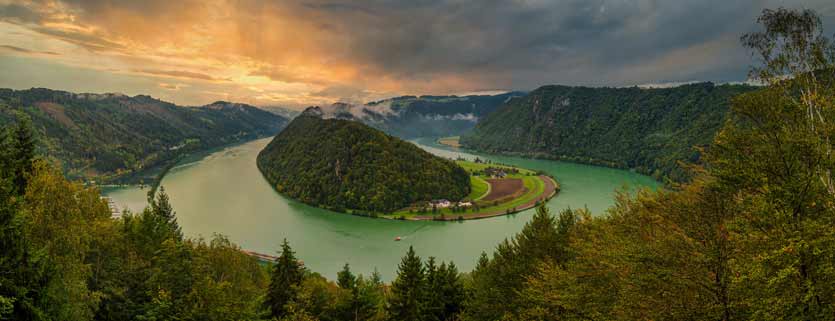The Danube river – from backwater to energy artery
Some days ago I met an old couple from Düsseldorf in the tram. They were on a Danube cruise from Düsseldorf through the Rhine, the Main, the Rhine-Main-Danube channel and all the Danube river down to the Black Sea and back. That’s an impressively long trip through the mightiest inland waterway system of Europe.
They were on the way back home and stopped for one day to relish Viennese delight. And they told me about their impressions.
In the middle of it all, they dropped a line that made me think, so much in fact that I grabbed my iPad to create a new post. Here is the line:
The difference between the Rhine and the Danube is that populations on the Rhine embrace the river. They live with the river, through the river, with their faces turned towards it. They define themselves through the river and use the river as a means of transport and to make their lives.
Danubians on the other side have turned their gaze away from the river. They experience the river as a sort of metaphor – knowing it’s there but they don’t embrace it, don’t use it, don’t live with it or through it. And that’s not limited to a city or two. It runs through the whole river system.
This is understandable in the lower reaches of the Danube, where at times it is hard to see the other side because the river is so large. Populations there might experience the river more like a coastline – like to open sea. But even then they don’t behave like normal seaborne populations and turn their back on it.
I drilled the subject and asked how they had come to this conclusion. They said that there is always something happening on the Rhine. The river is the center of action and there is a hell of a lot of traffic on it. People experience it as part of their lives and like to be on the riverside or do things on the river.
The Danube is more like a leftover from ancient times. There is abundant nature on its shores, you are the only vessel on the river sometimes for a long while. Sometimes you can be forgiven to think that the Danube is a leftover part of wilderness where man has chosen to absent himself.
And that exactly hits the current economic and political problem with the Danube on its head. Since the fall oft the Iron curtain, numerous initiatives have tried to infuse the river with life. To give it it’s deserved economic and also cultural clout.
Let’s take my home Vienna. Metaphorically at least, few things are more connected to my hometown than the Danube river. Johann Strauss immortalized it in his unforgettable tune “The Blue Danube”, a waltz that is part of any ballroom program.
For much of its history, the Danube has been one of the most important lifelines of the European continent. In Roman times it formed a defensive line against the barbarians in the North. Later, in Medieval times it was a transport and travel corridor which had brought riches to innumerable central European fiefdoms.
The Austro-Hungarian Empire had wrapped itself around the full length of the river and had defined itself around it.
After WW2, the Danube River was cut in half into the upper Danube flowing through the free part of Europe and a much longer lower piece draining a large part of what had been communist Europe. The separation was to be only the final sting of death to an already ailing river economy.
Since the fall of the Iron Curtain, the Danube – at least in theory – is a united river basin again and countries along it do cooperate pretty seamlessly. But despite all efforts, economically and even culturally the Danube is just a paltry cousin of the Rhine river which is – although far shorter – the economic powerhouse when it comes to inland shipping in Europe.
What’s wrong then?
Simple. The Rhine – besides the fact that it was not cut in half by the Cold War – pours its waters into one of the busiest commercial shipping hubs worldwide, the North-Western European coastline. Some of the biggest commercial ports like Rotterdam or Antwerp are located there. Lots of stuff to haul to and from the hinterland.
The Danube, on the other hand, goes east and terminates at the Black Sea which is economically a black hole. Nothing comparable with NW-Europe as Rotterdam alone is bigger than the whole Mediterranean and the Black Sea region taken together. That together with the old separation regime sealed its fate.
And here we are putting our finger exactly where it hurts. A river system is a travel destination in its own right at the very best if there is nothing that can economically be hauled on it. You need a source of the stuff – which are the big harbors in the Rhine’s case – and a big hinterland that gobbles up voraciously whatever is thrown at it. And that’s Germany’s heavy industries in the Ruhrpott and the cities farther south until Basel – all of them economic powerhouses.
Since the fall of the iron curtain, there have been countless initiatives to revive the Danube – all of them have been colossal money munchers. With not much to show for.
It’s still the same old problem. There is not much that is worth the pain to bring the Danube river up to the standards required for large scale commercial shipping. In order to really use the river big time, the riverbed would have to be dredged in some places, locks need upgrading and improvement, harbor facilities in some parts of the river are in a dismal state. And most commercial shippers on the river are only paid through subsidies to go up and down with no freight in order to give it a semblance of activity.
A river is a transport system and as such it’s an infrastructure piece that needs continuous investment in order to remain competitive. The Danube is so far behind on upgrading that it would take a mighty jolt to kick it back to life in one single piece. And then again, that’s just the chicken piece of the equation. The eggs would still be missing.
LNG could change this all. Because in order to revive the river we would need something that can be transported better on the river than on rail or road. And LNG could easily be such a thing.
Crude oil and its products are transported through pipelines. No luck for the big bulk transporter. But transporting LNG through a pipeline is very hard and should only be done over very, very short distances. I am talking about hundreds or thousands of meters at the very best or less. Certainly no hundreds or thousands of kilometers. The reason is the nature of LNG. It’s a boiling liquid and as such, it produces LNG vapor (which actually is Methane) which increases line pressure.
This can be dealt with, but it’s really expensive. LNG is better dealt with in big bulk. The bigger the bulk cargo, the less the Boil-Off effect as there is less opportunity for heat influx. So, pushing and pulling big LNG cargos through rivers at least theoretically makes a hell of a lot of sense.
You know me, I am convinced that LNG is going to replace diesel as a fuel and it’s not going to take 50 years. I believe that LNG will start making inroads in Europe by 2020 and it will become one of the bigger fuels by market share by 2030. So somehow the stuff will have to be moved around.
We can use road trailers but they are expensive by any standards and stringent eight limitations on European motorways make this an even more forbidding exercise. Every little bitsy lump of LNG needs driver’s intelligence in order to reach its point of use.
Rail is a much better solution as not every carriage needs a driver and cargos can be much bigger than for road trailers. But when it comes to making bulk real big nothing beats the waterway. For comparison.
It’s hard to go beyond 40m3 on the road in Europe; you can go up to 80 or even 100 m3 in extreme cases on rail. But you can put a whopping 2000m3 of LNG into a riverboat cargo hold and you can put some of them together for bigger compounds. That allows for more effective dealing with Boil-Off and it’s comparatively cheap – real cheap.
Besides, the river.boat can use the Boil-Off as a fuel which makes running the boats cheaper and cleaner.
But I have already said in a previous blog post – you cannot do everything at once. Someone needs to start somewhere. One cannot invest billions in heavy river upgrading before the market is there. First, we need to develop the market and that only works little by little. We need to establish LNG as a fuel – that’s the market. We need to show the people of Europe what LNG can do to their lives.
And there needs to be a starting point. Bringing LNG cargos from the estuary to Linz (as an example) does not make a lot of sense as its cheaper to produce LNG in situ and use the river as some sort of bulk distribution and storage system. Yes, you heard me right. Having some lighters filled with LNG at extremely cold weather at a strategic location on the river means rapid means of providing peak gas at peak times. Just like the peak shaving rapid-fire gas storage some cities have in place for days of extreme cold.
Developing LNG on the Danube between some cities that are close to each other would spark the bigger Danube river LNG economy all alone without the need for billions upfront. If – let’s say – one developed in Austria and another one in Hungary, they would tie up and connect loosely over time. No incentive needed as there will be plenty of potential for cooperation.
If Europe turns to LNG as a fuel, there will be cargo for thousands of barges on its rivers which will automatically revive the Danube river basin. No political initiative needed. All politicians need to do is to create a fiscal environment that favors LNG as a fuel for the next 10 years and then stand back and watch the scene unfold.













Leave a Reply
Want to join the discussion?Feel free to contribute!